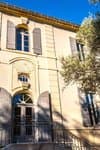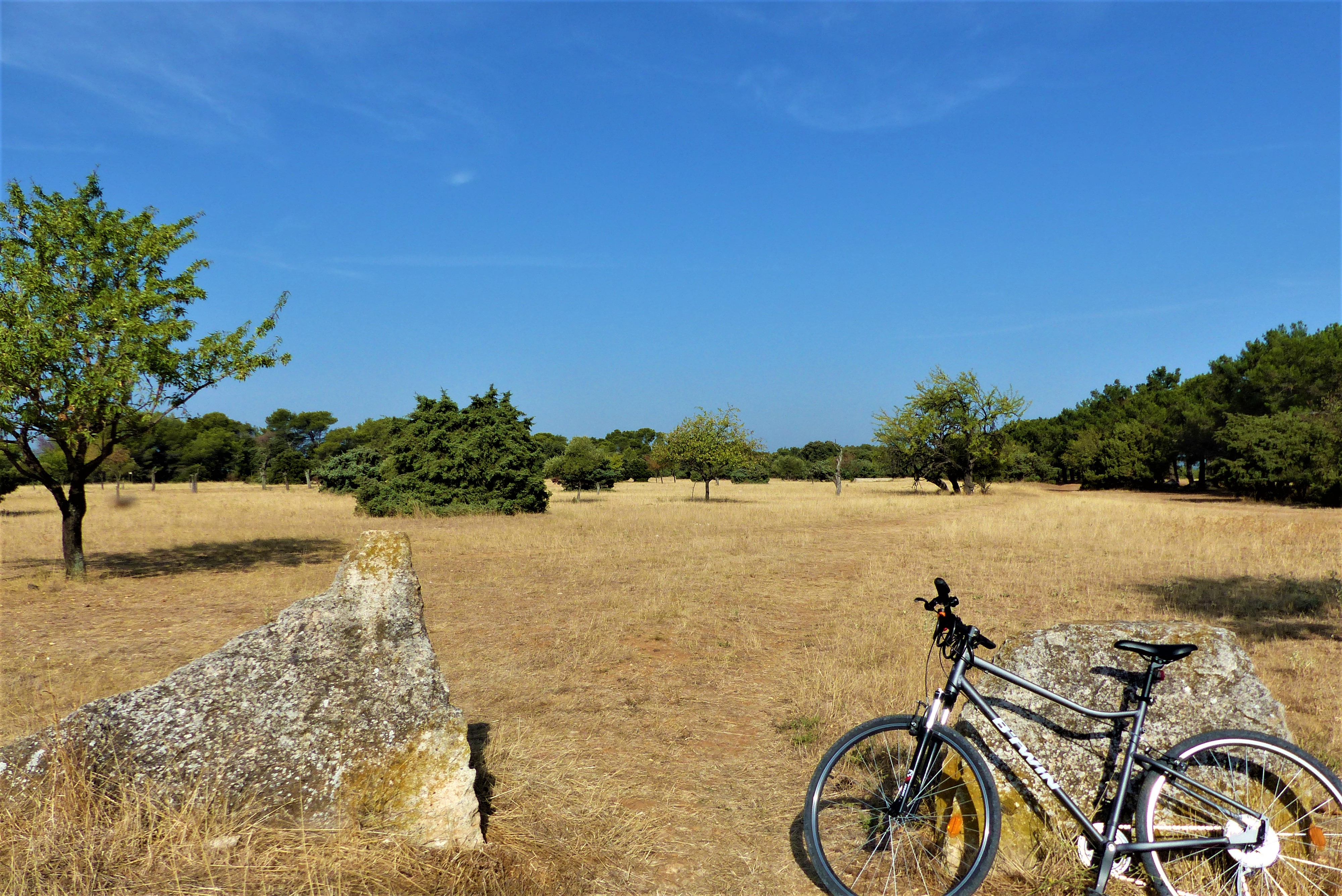
SAINT REMY DE PROVENCE - Pèr draio e pèr Camin in mountain bike
Across the Petite Crau plateau, north of Saint-Rémy-de-Provence, discover one of the transhumance routes, called "La Routo" in Provençal, which allowed herds to walk to the pastures. For a long time, the east lowland of Petite Crau was covered with swamps, thus obliging to pass by this plateau to connect the village of Saint-Rémy-de-Provence to that of Noves, while passing by Eyragues.
14 points of interest

Galets du coussoul de la Petite Crau - ©Rémi Sérange - PNR Alpilles  Geology
GeologyCoussoul of the Petite Crau
The coussoul is a steppe-style pastoral lawn, whose rough vegetation grows on very fine soil. This soil covers pebbles from the old bed of the Durance. Less than a meter deep, there is a layer of pebbles, cemented naturally by a crust of mineral salts, called "pudding". Within the Petite Crau, it is possible to find spaces of coussouls well preserved, giving it an exceptional ecological richness.

Ruines d'une ancienne bergerie - ©Rémi Sérange - PNR Alpilles  Elevage et pastoralisme
Elevage et pastoralismeRemains of pastoralism
La Petite Crau is a land of pastoralism. The extensive grazing of goats and sheep is a guarantor of biodiversity, preventing the encroachment and closing of environments, and at the same time contributing to the fight against fire. Herds appreciate the vegetation of the coussouls, as evidenced by this old sheepfold, now in ruins. ;

Musée du Patrimoine - ©Rémi Sérange - PNR Alpilles  Patrimony and history
Patrimony and historyThe Bastide
Inaugurated in 2006 by the association "Testimony and Heritage", the Heritage Museum exhibits everyday objects given by the inhabitants of the village of Eyragues who do not wish to see the disappearance of local heritage. There are stories about village life, paintings, furniture, traditional costumes and agricultural tools and crafts.
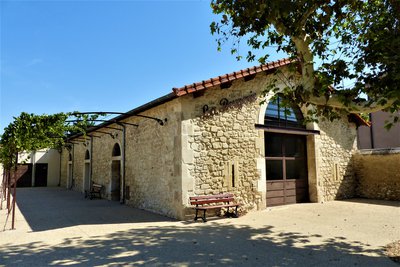
La Bergerie d'Eyragues - ©Rémi Sérange - PNR Alpilles  Elevage et pastoralisme
Elevage et pastoralismeThe sheepfold
Built in 1920 by;Jean-Ferdinand Michel, the sheepfold testifies to the pastoral life of the village of Eyragues. This sheepfold was home to a herd, which numbered up to 300 animals. The grandson of Jean-Ferdinand Michel practiced transhumance until 1985, and the sheepfold was used to keep a few heads until 1993. Today, the building has been rehabilitated in multi-purpose room by the municipality of Eyragues.

Allée des poètes - ©Rémi Sérange - PNR Alpilles  Patrimony and history
Patrimony and historyThe poets park
With this park the city of Eyragues pays homage to seven poets, whose works have allowed the maintenance of the Provençal language. There is a statue of Frédéric Mistral and the busts of Joseph Roumanille, Théodore Aubanel, Jean Brunet, Anselme Mathieu, Paul Giéra and Alphonse Tavan. In the background stands the Bastide, mansion, which houses a meeting room and the Heritage Museum.

Croix Saint Véran - ©Rémi Sérange - PNR Alpilles  Elevage et pastoralisme
Elevage et pastoralismeSaint-Véran Cross
Saint-Véran is the patron saint of shepherds and transhumance. North of Eyguières, there was once a chapel dedicated to him and a cross, still existing. Saint-Véran, bishop of Cavaillon, protector of the flocks, is known since the 11th century. for having chased the Tarasque, who decimated the herds in the valley of the Durance.

Vignobles d'Eyragues - ©Rémi Sérange - PNR Alpilles  Produits du terroir
Produits du terroirVines and olive groves
As in the Alpilles, the farmers of Eyragues offer a range of local diversified products, with among others the wine, the olives and their oils which represent a consequent part of the production. The plantations of vines and olive trees are thus structuring elements of the territory, offering agricultural landscapes open on the different neighboring massifs.
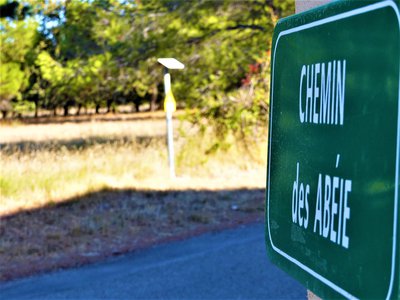
Panneau du chemin des Abéie - ©Rémi Sérange - PNR Alpilles  Elevage et pastoralisme
Elevage et pastoralismeAbeiè path
The route of the transhumance passed by the Abeiè path, Provençal name given to the transhumant herds. The width of the path was adapted to let them pass. In Noves, this path is called "Grande Draille". After the 2nd World War, there were 10,000 ewes, just on Noves, grazed during the year on the hill of Rougadou and on the flanks of Petite Crau.
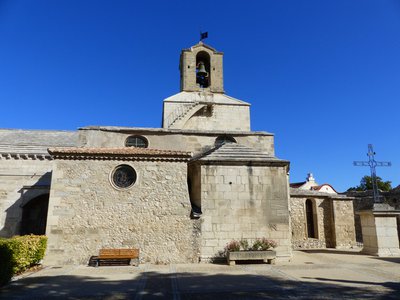
Eglise Saint-Baudile - ©Rémi Sérange - PNR Alpilles  Patrimony and history
Patrimony and historySaint-Baudile church
The construction of a church dedicated to Saint Baudile was ordered in the 10th century, so as to enlarge an already existing chapel. Saint Baudile was a Roman legionnaire converted to Christianity, who suffered martyrdom in 300 AD in Nîmes. Since then, he has become the patron saint of the Noves village. This Romanesque church occupies the site of an ancient place of worship, which was in the center of a Roman villa. ;

Place Lagnel - ©Rémi Sérange - PNR Alpilles  Elevage et pastoralisme
Elevage et pastoralismeLagnel Square
It is on the Lagnel square that a part of the transhumant herds passed the night while waiting to cross the Durance, to leave towards the mountain pastures. Noves remained for a long time anchored in pastoralism and cereal crops: each inhabitant had a few sheep and each house had a sheepfold to shelter them. It is only from the nineteenth century, that the activity of the town is moving towards market gardening and fruit trees.

Rivière de l'Anguillon - ©Rémi Sérange - PNR Alpilles  Water and rivers
Water and riversThe Anguillon
The Anguillon is a river of 20 km, which has its source in Saint-Rémy-de-Provence, at the foot of the Alpilles. It flows from south to north, to go to the Durance, near Châteaurenard. This river has played an important role over the centuries, providing the commune of Noves a refuelling point for livestock transhumance, but also the water needed for irrigation of vegetables and fruit trees.

Plantation de pommes Golden - ©Rémi Sérange - PNR Alpilles  Produits du terroir
Produits du terroirThe apple tree
In the 19th century, the Noves’economy leaves in small side of the pastoralism, to turn to the gardening and the culture of fruit trees. Since then, the south lowland of the village, where the Anguillon River flows, has specialized in apples production. Along this stream, there are many farms that produce mainly Golden and Gala varieties.

Notre-Dame-de-Vacquières - ©Rémi Sérange - PNR Alpilles  Elevage et pastoralisme
Elevage et pastoralismeNotre-Dame-de-Vacquières
In the 15th century, several farmhouses and sheepfolds were built in this area to accommodate herds of more than 1000 animals. Then came the construction of Notre-Dame-de-Vacquieres chapel and its hermitage This chapel is located near a source to which one attributes healing virtues, and a jas: a sheepfold allowing herds to shelter during the wintering period. From there, the flocks came down to drink in Anguillon.

Prairie de la Petite Crau - ©Rémi Sérange - PNR Alpilles  Elevage et pastoralisme
Elevage et pastoralismeLa Petite Crau
La Petite Crau presents an ecosystem close to its big sister, the Crau, lowland located south of the Alpilles. The landscape is characterized by hedges, groves and old trees surrounding still some natural meadows, typical of the coussouls. More and more plots are being cultivated today, the presence of herds is essential to maintain their ecosystem, because pasture is the only way to enhance the pastoral lawns of the coussouls of Petite Crau.
Description
Back to the car park, take the path on the left, follow it for 3.5 km and pass a panel of communal decree. At the next intersection, turn left. Go right on the white gravel path and follow it to the road.
1- Turn left, pass the water tower and in the bend turn on the 2nd street on the left. Go down to the roundabout. Take the 2nd exit and take the avenue on the left. Turn left and cross the Liberation and Saint-Paul squares to reach the Bergerie.
2- Retrace your steps and take a right on the street just before the pharmacy. At the intersection, stay left and continue to the canal. Follow it on the right. At the end of the road, turn right. Turn left and pass the Roumanille manade.
3- Climb the path to the right and pass the canal. Once the hill is completed, switch on the path to the right. Take the road on the right, then turn left on the path of Mas de Bedoc. At the intersection, turn left on the path. At the end, turn left on a road. Follow it until you reach the D30b.
4- Continue towards Noves. After 300 m follow the Abeies path on the left, then the Crêtes path. At the end, take on the left the D30b to join Noves and the D30. Turn to the left. Follow the direction Châteaurenard and pass three roundabouts. After the 3rd, go left the medieval gate.
5- Just after, turn right, join the Pagnel square and continue Paul Auran street. At the end, turn right, then direct left. Take the D30b on the right. 1 km further, take a path on the left (n°941). At the end, turn left, cross the river and turn right (Mas Vert). Follow this path for 2 km.
6- Follow the road to the right. Go The river and at the intersection, take to the right. After 700 m, fork left on the Chicard de Pouvarel draille. Borrow the 1st road on the right. Go up the road on the left and join point 4. Follow the path of Transhumance on the left. Continue straight for 7.5 km to return to the starting point.
- Departure : Petite Crau car park, Saint-Rémy-de-Provence
- Arrival : Saint-Rémy-de-Provence
- Towns crossed : Saint-Rémy-de-Provence, Eyragues, and Noves
Forecast
Altimetric profile
Recommandations
For your safety, and for the preservation of forest areas, access to natural areas is regulated from June to September. IInformation during the summer period on 08 11 20 13 13 (price of a local call), on www.bouches-du-rhone.pref.gouv.fr, or on the free application MYPROVENCE ENVIE DE BALADE (available on the App Store and Android Market).
Information desks
House of the Alpilles Regional Nature Park
2, boulevard Marceau, 13210 Saint-Rémy-de-Provence
Located in the heart of the city centre of Saint-Rémy-de-Provence, the House of the Alpilles Nature Park welcomes you to its completely renovated premises. This new vibrant place is multifunctional: it accommodates the Park's engineering team but also has a public reception space and showrooms. A true resource centre of the Park's heritage, it aims to support and promote locals, visitors and tourists on all 16 municipalities of the Park.
Open Monday to Friday, from 9 am at 12:30 pm and from 1:30 pm to 5 pm.
Free admission.
OTI Alpilles-en-Provence
Place Jean Jaurès, 13210 Saint-Rémy-de-Provence
Transport
Access and parking
Parking :
Report a problem or an error
If you have found an error on this page or if you have noticed any problems during your hike, please report them to us here:

